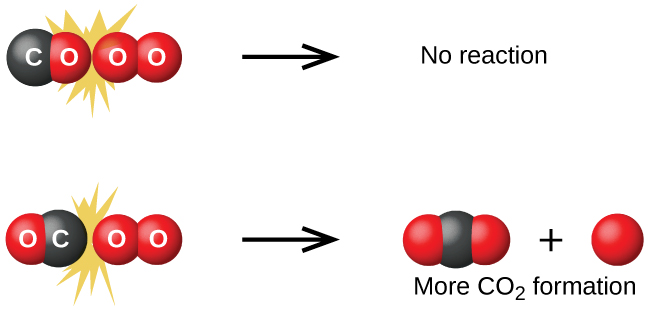
By the end of this section, you will be able to:
We should not be surprised that atoms, molecules, or ions must collide before they can react with each other. Atoms must be close together to form chemical bonds. This simple premise is the basis for a very powerful theory that explains many observations regarding chemical kinetics, including factors affecting reaction rates.
Collision theory is based on the following postulates:
The rate of a reaction is proportional to the rate of reactant collisions:
The reacting species must collide in an orientation that allows contact between the atoms that will become bonded together in the product.
The collision must occur with adequate energy to permit mutual penetration of the reacting species’ valence shells so that the electrons can rearrange and form new bonds (and new chemical species).
We can see the importance of the two physical factors noted in postulates 2 and 3, the orientation and energy of collisions, when we consider the reaction of carbon monoxide with oxygen:
Carbon monoxide is a pollutant produced by the combustion of hydrocarbon fuels. To reduce this pollutant, automobiles have catalytic converters that use a catalyst to carry out this reaction. It is also a side reaction of the combustion of gunpowder that results in muzzle flash for many firearms. If carbon monoxide and oxygen are present in sufficient quantity, the reaction is spontaneous at high temperature and pressure.
The first step in the gas-phase reaction between carbon monoxide and oxygen is a collision between the two molecules:
Although there are many different possible orientations the two molecules can have relative to each other, consider the two presented in [link]. In the first case, the oxygen side of the carbon monoxide molecule collides with the oxygen molecule. In the second case, the carbon side of the carbon monoxide molecule collides with the oxygen molecule. The second case is clearly more likely to result in the formation of carbon dioxide, which has a central carbon atom bonded to two oxygen atoms
This is a rather simple example of how important the orientation of the collision is in terms of creating the desired product of the reaction.

If the collision does take place with the correct orientation, there is still no guarantee that the reaction will proceed to form carbon dioxide. In addition to a proper orientation, the collision must also occur with sufficient energy to result in product formation. When reactant species collide with both proper orientation and adequate energy, they combine to form an unstable species called an activated complex or a transition state. As an example, [link] depicts the structure of possible transitions states in the reaction between CO and O2 to form CO2.
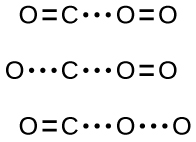
In most circumstances, it is impossible to isolate or identify a transition state or activated complex. In the reaction between carbon monoxide and oxygen to form carbon dioxide, activated complexes have only been observed spectroscopically in systems that utilize a heterogeneous catalyst. The gas-phase reaction occurs too rapidly to isolate any such chemical compound.
Collision theory explains why most reaction rates increase as concentrations increase. With an increase in the concentration of any reacting substance, the chances for collisions between molecules are increased because there are more molecules per unit of volume. More collisions mean a faster reaction rate, assuming the energy of the collisions is adequate.
The minimum energy necessary to form a product during a collision between reactants is called the activation energy (Ea). The kinetic energy of reactant molecules plays an important role in a reaction because the energy necessary to form a product is provided by a collision of a reactant molecule with another reactant molecule. (In single-reactant reactions, activation energy may be provided by a collision of the reactant molecule with the wall of the reaction vessel or with molecules of an inert contaminant.) If the activation energy is much larger than the average kinetic energy of the molecules, the reaction will occur slowly: Only a few fast-moving molecules will have enough energy to react. If the activation energy is much smaller than the average kinetic energy of the molecules, the fraction of molecules possessing the necessary kinetic energy will be large; most collisions between molecules will result in reaction, and the reaction will occur rapidly.
[link] shows the energy relationships for the general reaction of a molecule of A with a molecule of B to form molecules of C and D:
The figure shows that the energy of the transition state is higher than that of the reactants A and B by an amount equal to Ea, the activation energy. Thus, the sum of the kinetic energies of A and B must be equal to or greater than Ea to reach the transition state. After the transition state has been reached, and as C and D begin to form, the system loses energy until its total energy is lower than that of the initial mixture. This lost energy is transferred to other molecules, giving them enough energy to reach the transition state. The forward reaction (that between molecules A and B) therefore tends to take place readily once the reaction has started. In [link], ΔH represents the difference in enthalpy between the reactants (A and B) and the products (C and D). The sum of Ea and ΔH represents the activation energy for the reverse reaction:
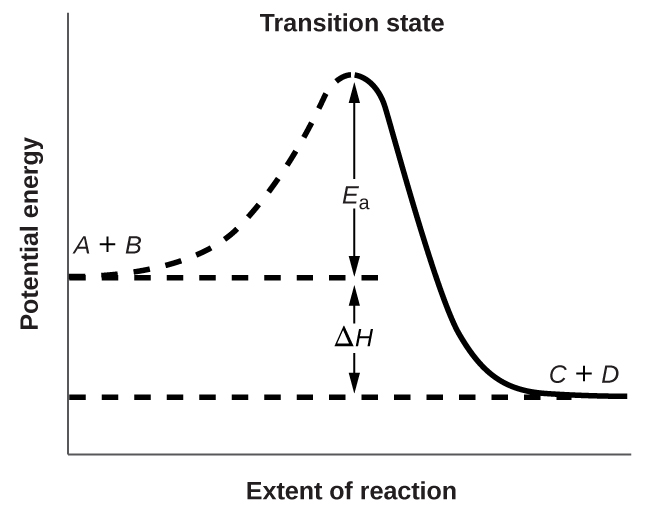
We can use the Arrhenius equation to relate the activation energy and the rate constant, k, of a given reaction:
In this equation, R is the ideal gas constant, which has a value 8.314 J/mol/K, T is temperature on the Kelvin scale, Ea is the activation energy in joules per mole, e is the constant 2.7183, and A is a constant called the frequency factor, which is related to the frequency of collisions and the orientation of the reacting molecules.
The postulates of collision theory are accommodated in the Arrhenius equation. The frequency factor A is related to the rate at which collisions having the correct orientation occur. The exponential term,
is related to the fraction of collisions providing adequate energy to overcome the activation barrier of the reaction.
At one extreme, the system does not contain enough energy for collisions to overcome the activation barrier. In such cases, no reaction occurs. At the other extreme, the system has so much energy that every collision with the correct orientation can overcome the activation barrier, causing the reaction to proceed. In such cases, the reaction is nearly instantaneous.
The Arrhenius equation describes quantitatively much of what we have already discussed about reaction rates. For two reactions at the same temperature, the reaction with the higher activation energy has the lower rate constant and the slower rate. The larger value of Ea results in a smaller value for
reflecting the smaller fraction of molecules with enough energy to react. Alternatively, the reaction with the smaller Ea has a larger fraction of molecules with enough energy to react. This will be reflected as a larger value of
a larger rate constant, and a faster rate for the reaction. An increase in temperature has the same effect as a decrease in activation energy. A larger fraction of molecules has the necessary energy to react ([link]), as indicated by an increase in the value of
The rate constant is also directly proportional to the frequency factor, A. Hence a change in conditions or reactants that increases the number of collisions with a favorable orientation for reaction results in an increase in A and, consequently, an increase in k.
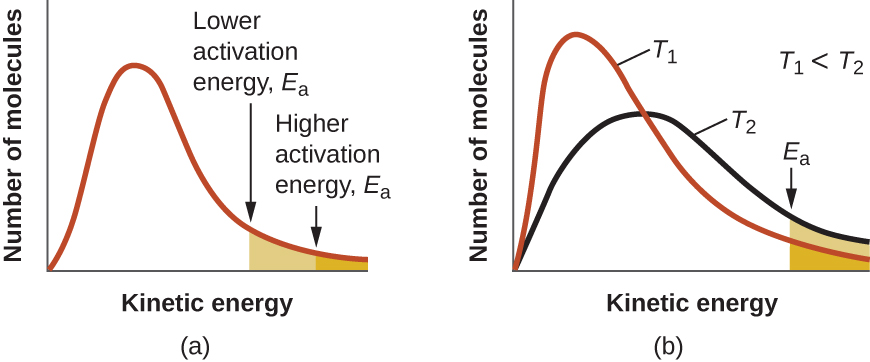
A convenient approach for determining Ea for a reaction involves the measurement of k at different temperatures and using an alternate version of the Arrhenius equation that takes the form of a linear equation
Thus, a plot of ln k versus
gives a straight line with the slope
from which Ea may be determined. The intercept gives the value of ln A.
Determination of Ea The variation of the rate constant with temperature for the decomposition of HI(g) to H2(g) and I2(g) is given here. What is the activation energy for the reaction?
| T (K) | k (L/mol/s) | {: valign=”middle”}|———- | 555 | 3.52
| 10−7 | ||
| {: valign=”middle”} | 575 | 1.22 |
| 10−6 | ||
| {: valign=”middle”} | 645 | 8.59 |
| 10−5 | ||
| {: valign=”middle”} | 700 | 1.16 |
| 10−3 | ||
| {: valign=”middle”} | 781 | 3.95 |
10−2 | {: valign=”middle”}{: summary=”This table has two columns and six rows. The first column is labeled, “T ( K ),” and the second is labeled, “k ( L / mol / s ).” Under the first column are the numbers: 555, 575, 645, 700, and 781. Under the second column are the numbers: 3.52 times ten to the negative 7; 1.22 times ten to the negative 6; 8.59 times ten to the negative 5; 1.16 times ten to the negative 3; and 3.95 times ten to the negative 2.” .medium .unnumbered data-label=””}
Solution Values of
and ln k are:
| ln k | |
| {: valign=”middle”} | ———- |
| 1.80 |
| 10−3 | −14.860 |
| {: valign=”middle”} | 1.74 |
| 10−3 | −13.617 |
| {: valign=”middle”} | 1.55 |
| 10−3 | −9.362 |
| {: valign=”middle”} | 1.43 |
| 10−3 | −6.759 |
| {: valign=”middle”} | 1.28 |
10−3 | −3.231 | {: valign=”middle”}{: summary=”This table has two columns and six rows. The first row is labeled, “1 over T ( K superscript negative 1 ),” and, “l n k.” Under the first column are the numbers: 1.80 times ten to the negative 3; 1.74 times ten to the negative 3; 1.55 times ten to the negative 3; 1.43 times ten to the negative 3; and 1.28 times ten to the negative 3. Under the second column are the numbers: negative 14.860, negative 13.617, negative 9.362, negative 6.759, and negative 3.231.” .medium .unnumbered data-label=””}
[link] is a graph of ln k versus
To determine the slope of the line, we need two values of ln k, which are determined from the line at two values of
(one near each end of the line is preferable). For example, the value of ln k determined from the line when
is −2.593; the value when
is −14.447.
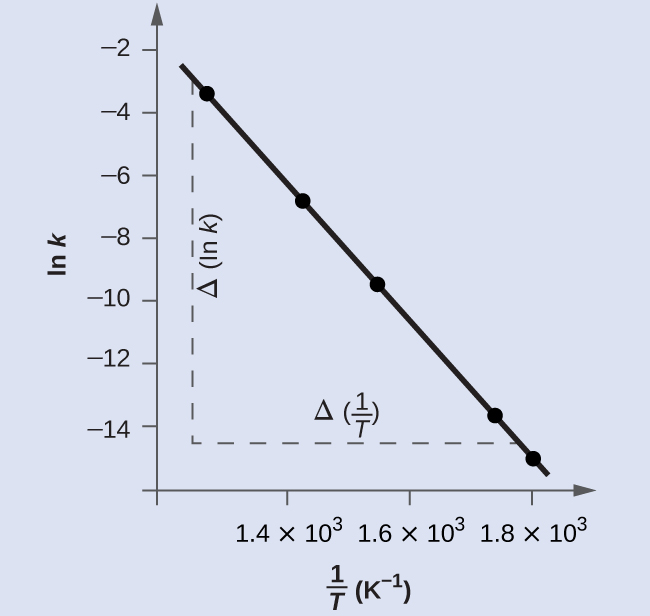
The slope of this line is given by the following expression:
Thus:
In many situations, it is possible to obtain a reasonable estimate of the activation energy without going through the entire process of constructing the Arrhenius plot. The Arrhenius equation:
can be rearranged as shown to give:
or
This equation can be rearranged to give a one-step calculation to obtain an estimate for the activation energy:
Using the experimental data presented here, we can simply select two data entries. For this example, we select the first entry and the last entry:
| T (K) | k (L/mol/s) |
| ln k | |
| {: valign=”middle”} | ———- |
| 555 | 3.52 |
| 10−7 | 1.80 |
| 10−3 | −14.860 | |
| {: valign=”middle”} | 781 | 3.95 |
| 10−2 | 1.28 |
10−3 | −3.231 | {: valign=”middle”}{: summary=”This table contains four columns and three rows. The first row is a header row, and it labels each column, “T ( K ),” “k ( L / mol / s ),” “1 over T ( K superscript negative 1),” and, “l n k.” Under the “T ( K )” column are the numbers 555 and 781. Under the “k ( L / mol / s )” column are the numbers 3.52 times ten to the negative 7 and 3.95 times ten to the negative 2. Under the “1 over T ( K superscript negative 1)” column are the numbers 1.80 times ten to the negative 3 and 1.28 times ten to the negative 3. Under the “l n k” column are the numbers negative 14.860 and negative 3.231.” .medium .unnumbered data-label=””}
After calculating
and ln k, we can substitute into the equation:
and the result is Ea** = 185,900 J/mol.
This method is very effective, especially when a limited number of temperature-dependent rate constants are available for the reaction of interest.
Check Your Learning The rate constant for the rate of decomposition of N2O5 to NO and O2 in the gas phase is 1.66 L/mol/s at 650 K and 7.39 L/mol/s at 700 K:
Assuming the kinetics of this reaction are consistent with the Arrhenius equation, calculate the activation energy for this decomposition.
113,000 J/mol
Chemical reactions require collisions between reactant species. These reactant collisions must be of proper orientation and sufficient energy in order to result in product formation. Collision theory provides a simple but effective explanation for the effect of many experimental parameters on reaction rates. The Arrhenius equation describes the relation between a reaction’s rate constant and its activation energy, temperature, and dependence on collision orientation.
Chemical reactions occur when reactants collide. What are two factors that may prevent a collision from producing a chemical reaction?
The reactants either may be moving too slowly to have enough kinetic energy to exceed the activation energy for the reaction, or the orientation of the molecules when they collide may prevent the reaction from occurring.
When every collision between reactants leads to a reaction, what determines the rate at which the reaction occurs?
What is the activation energy of a reaction, and how is this energy related to the activated complex of the reaction?
The activation energy is the minimum amount of energy necessary to form the activated complex in a reaction. It is usually expressed as the energy necessary to form one mole of activated complex.
Account for the relationship between the rate of a reaction and its activation energy.
Describe how graphical methods can be used to determine the activation energy of a reaction from a series of data that includes the rate of reaction at varying temperatures.
After finding k at several different temperatures, a plot of ln k versus
gives a straight line with the slope
from which Ea may be determined.
How does an increase in temperature affect rate of reaction? Explain this effect in terms of the collision theory of the reaction rate.
The rate of a certain reaction doubles for every 10 °C rise in temperature.
(a) How much faster does the reaction proceed at 45 °C than at 25 °C?
(b) How much faster does the reaction proceed at 95 °C than at 25 °C?
(a) 4-times faster (b) 128-times faster
In an experiment, a sample of NaClO3 was 90% decomposed in 48 min. Approximately how long would this decomposition have taken if the sample had been heated 20 °C higher? (Hint: Assume the rate doubles for each 10 °C rise in temperature.)
The rate constant at 325 °C for the decomposition reaction
is 6.1
10−8 s−1, and the activation energy is 261 kJ per mole of C4H8. Determine the frequency factor for the reaction.
The rate constant for the decomposition of acetaldehyde, CH3CHO, to methane, CH4, and carbon monoxide, CO, in the gas phase is 1.1
10−2 L/mol/s at 703 K and 4.95 L/mol/s at 865 K. Determine the activation energy for this decomposition.
An elevated level of the enzyme alkaline phosphatase (ALP) in human serum is an indication of possible liver or bone disorder. The level of serum ALP is so low that it is very difficult to measure directly. However, ALP catalyzes a number of reactions, and its relative concentration can be determined by measuring the rate of one of these reactions under controlled conditions. One such reaction is the conversion of p-nitrophenyl phosphate (PNPP) to p-nitrophenoxide ion (PNP) and phosphate ion. Control of temperature during the test is very important; the rate of the reaction increases 1.47 times if the temperature changes from 30 °C to 37 °C. What is the activation energy for the ALP–catalyzed conversion of PNPP to PNP and phosphate?
43.0 kJ/mol
In terms of collision theory, to which of the following is the rate of a chemical reaction proportional?
(a) the change in free energy per second
(b) the change in temperature per second
(c) the number of collisions per second
(d) the number of product molecules
Hydrogen iodide, HI, decomposes in the gas phase to produce hydrogen, H2, and iodine, I2. The value of the rate constant, k, for the reaction was measured at several different temperatures and the data are shown here:* * *
| Temperature (K) | k (M−1 s−1) |
| {: valign=”middle”} | ———- |
| 555 | 6.23 |
| 10−7 | ||
| {: valign=”middle”} | 575 | 2.42 |
| 10−6 | ||
| {: valign=”middle”} | 645 | 1.44 |
| 10−4 | ||
| {: valign=”middle”} | 700 | 2.01 |
10−3 | {: valign=”middle”}{: summary=”This table has two columns and five rows. The first column is labeled, “Temperature ( K ),” and the second column is labeled, “k ( M superscript negative 1 s superscript negative 1 ).” Under the first column are the numbers: 555, 575, 645, and 700. Under the second column are the numbers: 6.23 times ten to the negative 7; 2.42 times ten to the negative 6; 1.44 times ten to the negative 4; and 2.01 times ten to the negative 3.” .medium .unnumbered data-label=””}
What is the value of the activation energy (in kJ/mol) for this reaction?
177 kJ/mol
The element Co exists in two oxidation states, Co(II) and Co(III), and the ions form many complexes. The rate at which one of the complexes of Co(III) was reduced by Fe(II) in water was measured. Determine the activation energy of the reaction from the following data:* * *
| T (K) | k (s−1) | {: valign=”middle”}|———- | 293 | 0.054 | {: valign=”middle”}| 298 | 0.100 | {: valign=”middle”}{: summary=”This table contains two columns and three rows. The first row is a header row, and it labels each column, “T ( K )” and “k ( s superscript negative 1 ).” Under the first column are the numbers 293 and 298. Under the second column are the numbers 0.054 and 0.100.” .medium .unnumbered data-label=””}
The hydrolysis of the sugar sucrose to the sugars glucose and fructose,* * *
follows a first-order rate equation for the disappearance of sucrose: Rate = k[C12H22O11] (The products of the reaction, glucose and fructose, have the same molecular formulas but differ in the arrangement of the atoms in their molecules.)
(a) In neutral solution, k = 2.1
10−11 s−1 at 27 °C and 8.5
10−11 s−1 at 37 °C. Determine the activation energy, the frequency factor, and the rate constant for this equation at 47 °C (assuming the kinetics remain consistent with the Arrhenius equation at this temperature).
(b) When a solution of sucrose with an initial concentration of 0.150 M reaches equilibrium, the concentration of sucrose is 1.65
10−7 M. How long will it take the solution to reach equilibrium at 27 °C in the absence of a catalyst? Because the concentration of sucrose at equilibrium is so low, assume that the reaction is irreversible.
(c) Why does assuming that the reaction is irreversible simplify the calculation in part (b)?
Ea = 108 kJ* * *
A = 2.0
108 s−1* * *
k = 3.2
10−10 s−1* * *
(b) 1.81
108 h or 7.6
106 day. (c) Assuming that the reaction is irreversible simplifies the calculation because we do not have to account for any reactant that, having been converted to product, returns to the original state.
Use the PhET Reactions & Rates interactive simulation to simulate a system. On the “Single collision” tab of the simulation applet, enable the “Energy view” by clicking the “+” icon. Select the first
reaction (A is yellow, B is purple, and C is navy blue). Using the “straight shot” default option, try launching the A atom with varying amounts of energy. What changes when the Total Energy line at launch is below the transition state of the Potential Energy line? Why? What happens when it is above the transition state? Why?
Use the PhET Reactions & Rates interactive simulation to simulate a system. On the “Single collision” tab of the simulation applet, enable the “Energy view” by clicking the “+” icon. Select the first
reaction (A is yellow, B is purple, and C is navy blue). Using the “angled shot” option, try launching the A atom with varying angles, but with more Total energy than the transition state. What happens when the A atom hits the BC molecule from different directions? Why?
The A atom has enough energy to react with BC; however, the different angles at which it bounces off of BC without reacting indicate that the orientation of the molecule is an important part of the reaction kinetics and determines whether a reaction will occur.

You can also download for free at http://cnx.org/contents/85abf193-2bd2-4908-8563-90b8a7ac8df6@12.1
Attribution: